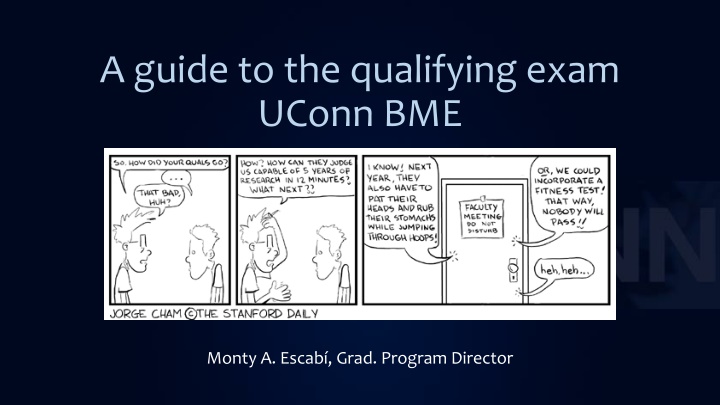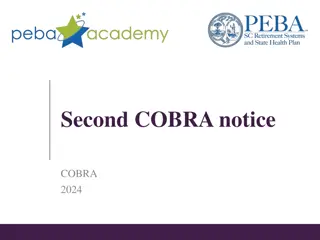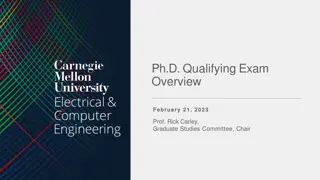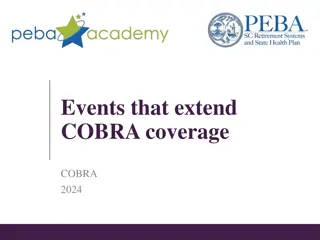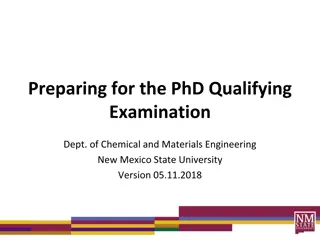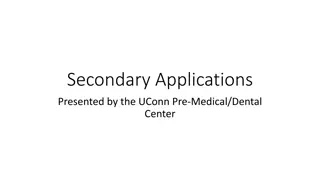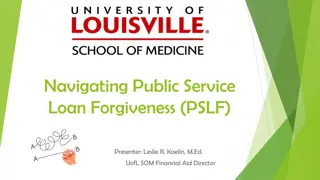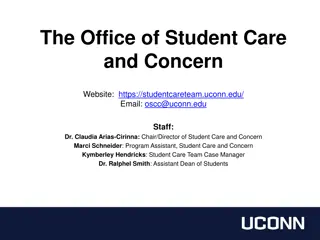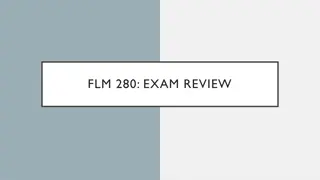Guide to Qualifying Exam at UConn BME Program
This guide outlines the importance of the Qualifying Exam as a rite of passage and a critical assessment of skills in written/oral communication, research project design, critical thinking, and more. It details the exam format, rubric, timeline, and key dates, providing insights into the NIH-style Written Component and Oral Component, along with assessment criteria. Candidates learn about the examination structure, scoring criteria, and the process of defending an R01 proposal. The guide emphasizes the significance of the Qualifying Exam in evaluating readiness for scholarly work and research in various tracks and areas of study.
Download Presentation

Please find below an Image/Link to download the presentation.
The content on the website is provided AS IS for your information and personal use only. It may not be sold, licensed, or shared on other websites without obtaining consent from the author.If you encounter any issues during the download, it is possible that the publisher has removed the file from their server.
You are allowed to download the files provided on this website for personal or commercial use, subject to the condition that they are used lawfully. All files are the property of their respective owners.
The content on the website is provided AS IS for your information and personal use only. It may not be sold, licensed, or shared on other websites without obtaining consent from the author.
E N D
Presentation Transcript
A guide to the qualifying exam UConn BME Monty A. Escab , Grad. Program Director
Why do I have to take a Qualifying Exam? Yes but there is more to it. It s a rite of passage. Develop critical skills Written and oral communication skills Research project design and development Critical thinking Assessment Your readiness for doing scholarly work and research Basic knowledge in your track and research area Your ability to think outside the box and think globally
Exam Format Written Component Formatted in the style of NIH style research project grant proposal (R01) . Topics for each track are selected 2 month prior to the completion of the qualifying exams by a committee of faculty within each respective tract. Oral Component The student is required to defend the RO1 proposal as part of an oral examination. Presentation should be <30 min Total time including question session should be <2 hours. Assessment and Outcomes The advisory committee makes a pass/fail decision based on the combined results of the written component and oral presentation. In the event of an unsuccessful attempt, the exam may be repeated once if necessary and at the discretion of the committee.
Exam Rubric R1 R2 R3 Avg. A. Written proposal (grammar, clarity) B. Hypothesis and Aims C. Methodology proposed within the grant application D. Oral Presentation (slides and student question and answer capability and composure under stress) E. Comprehension and understanding of the literature and field of study Items A-E are scored using a 1-5 rating system (1=poor; 2=fair; 3=average; 4=good; 5=excellent). Individual reviewer scores (R1, R2 and R3) and average (Avg.) scores of the committee. A passing grade is contingent on receiving an average 3.0 or above score on all items A
Exam Timeline Key Dates: 5/9 (a) 6/20 (b) 7/15 (c) a. Topics given to students + begin a 6-week writing period Students to submit Abstract page @Week 1 Committees to screen for fairness and provide brief comments to student. Aims must not overlap with PI s current research Aims. b. Proposals due + oral presentations begin Student s oral presentation =< 30 min; combined with Q&As, entire session <=2 hours. PIs may watch student s presentation, but cannot ask questions. c. Committees makes final decision Possible outcomes - pass, fail, or conditional pass Resubmission may be due in 2 weeks For fail, student will have another opportunity to take the exam
NIH Research Project Grants (R01) 8. Title Limited to 81 characters 10. Project Summary (abstract) <30 lines of text Summary of proposed activity suitable for dissemination to public (e.g., media) Provide information on significance (e.g., public health relevance) 11. Project Narrative < 3 sentences. Describe relevance to public health. Should be succinct and use plain language suitable for a lay audience. 13. Specific Aims 1 page limit State the goals and objectives of the proposed research. Summarize the expected outcomes and including impact of research on fields involved.
NIH Research Project Grants (R01, continued) 14. Research Strategy Limited to 12 pages Bulk of the proposal A. Significance Describe the importance of the project within your field and the critical scientific/clinical questions it will address. Describe how the project will contribute towards scientific knowledge, development of technologies and capabilities (research or clinical) in your field. Describe how clinical and/or research concepts, methods, technologies, treatments and interventions will be enhanced in your field if the project aims are achieved. B. Innovation Explain how the project challenges scientific conventions and seeks Describe advantages over existing methods. Describe novel theoretical approaches and concepts that will arise from the research. C. Approach Describe the research strategy, methodology and analysis that will be carried out in order to accomplish the specific aims of the proposal. Discuss potential problems, alternative strategies and benchmarks for successful completion of the project.
Resources BME Quals page: https://www.bme.uconn.edu/doctoral-qualifying-exam/ Sample R01 Proposals: https://www.niaid.nih.gov/grants-contracts/sample-applications#r01 R01 Instructions (SF 424 Form): https://grants.nih.gov/grants/how-to-apply-application-guide/forms- g/general-forms-g.pdf George Cham s Piled Higher and Deeper (PHD) Comics - https://phdcomics.com
